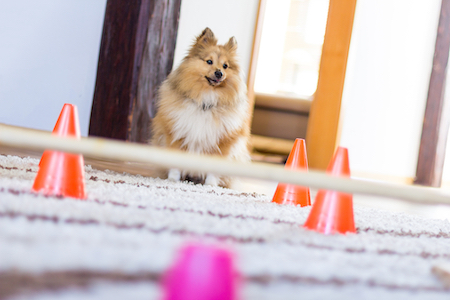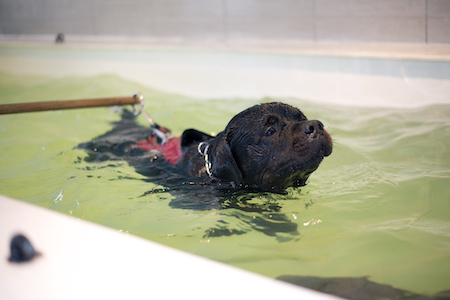Pet Insurance Review > Pet Wellness Guides > 5 Easy Tips to Help Your Dog Lose Weight this Winter - Pet Insurance Review
5 Easy Tips to Help Your Dog Lose Weight this Winter
Posted: 11/06/2023 | BY: Erin Cain | Categories: Uncategorized
It’s wintertime, and many pet parents notice that their pet is starting to pack on the pounds. Whether from lack of exercise or excess food, pet weight gain during the winter months is a common concern. Veterinarians estimate that nearly 59% of all pets are obese, with an increase of excess weight gain of 158% in dogs over the last decade. By 18 months of age, around 37% of pups are already overweight, leading to a higher chance of future health issues. Unfortunately, winter weather woes combined with inactivity can put your pup on the path to weight gain. But don’t worry! Dog owners can do plenty of things to help their pets lose weight this season. Here are 5 easy tips to make your dog healthier by focusing on fewer calories, a healthy weight loss goal, and daily exercise.

1. Extend daily walks as much as possible.
To help your dog lose weight, increase the intensity and length of her daily walks. The average pace for humans who walk with a pup is 20-25 minutes per mile which is simply considered a stroll. If an overweight dog is not walking often enough or at a faster pace than usual, then the exercise won’t be effective in helping the pet’s weight loss journey.
Do you and your dog live somewhere too cold for 30 minutes or longer daily walks? Look for indoor dog park playgrounds, or consider signing your dog up for doggy daycare a few days a week to allow your pup to burn some calories in a comfortable environment.
If you own a treadmill, you can also use it to help your pup get her steps in every day without the distraction of enticing smells, noises, and other dogs you may encounter on an outdoor walk. Plus, a treadmill allows you to keep track of your dog’s mileage and calories burned.

2. Measure your dog’s daily food intake.
When it comes to your dog’s weight problem, a simple measuring cup is the best solution. It can be used as an accurate calorie counter and make sure you are giving your pup enough food with healthy portions. You now have an opportunity to start measuring your dog’s food for accurate portions. If you are used to filling up her dish with kibble, letting her free-feed, or trying to estimate or eyeball how much is enough food on your own, you are likely feeding your pup more food than she needs.
How many calories does your dog require daily? Ask your veterinarian for an exact measurement of how much food your dog should eat, and stick with that pre-portioned amount — no matter how many times your pup stares at you with pleading eyes. To help your pet lose weight, your pet’s food must be carefully accounted for, so prepare to count calories. The veterinarian will give you an ideal weight and weight loss plan for your dog to prevent excess weight gain and health problems, such as high blood pressure and joint problems.
Low fat, high-quality food, and dog diet dry food brands can help you control your pup’s calorie intake and thus the amount of actual pet cuisine needed for each meal. Skip free feeding in favor of a more portion-controlled, weight loss approach. It’ll be worth all those extra calories to see your dog at an ideal body weight instead of struggling with a few extra pounds.

3. Cut back on treats and table scraps.
No, you don’t have to be a grinch about your dog’s favorite treats, but all pup parents should be more aware of how many treats or table scraps they give to their dogs each day. Those treats, just like human snacks, add up fast. Some people express their affection for the pet by providing regular, often high-calorie treats. Four or five snacks convert into another meal’s worth of added fat and more calories, so it’s easy to see why a dog who frequently eats treats may also carry some extra weight.
You can still give your dog treats but within reason. Giving your dog treats is a great way to show her that you care, but it’s essential not to let them make up more than 10% of her daily caloric intake. Many dog owners associate food with showing their pup love, but this habit can wreck a weight loss diet and lead to overweight pets. Divide each treat into pieces so she doesn’t notice any decrease in food quantity or quality while enjoying the rewards.
Also, you can make sure your dog’s snacks are healthy and made with single-ingredient treats. Switch out sugary commercial treats for natural homemade ones, which you can either purchase or make yourself following easy recipes. Better yet, start to replace your dog’s high-fat treats with low-calorie vegetables as snacks, like baby carrots, green beans, broccoli, and other healthy treats.

4. Create fun indoor challenges for your pup.
When you come up with new ideas for games to play with your dog, it’s not just about the fun of playing together. Not only will this be motivational for your dog, but also be mentally stimulating and good exercise. Even when the winter weather is too cold to play outside, indoor games can be just as mentally and physically stimulating for your dog. Try games like healthy treat scavenger hunts, DIY indoor obstacle courses, and Simon Says as fun ways to keep your dog on the move inside the home.
Additionally, you can work small exercises into your dog’s daily life. Move your dog’s food bowl up or downstairs, changing its location frequently so that the pup always has to walk across the house to get their paws on some grub. Most dogs will catch on to this game quickly and enjoy the challenge of finding their food bowl. You can also engage with your pup in some fun interactive games. Toys, tennis balls, or laser pointers can all be used in different ways that will encourage your dog to play and move more often. Aim to play twice a day for 15 minutes a session.
Be prepared to keep indoor exercises and games fresh. Some dogs need a lot of variety to keep their interests fresh. The best way for you and your dog’s mental health is by providing challenging activities that he can do with ease or passion. Change up the games and provide variety for your dog’s mental, physical, and emotional wellbeing.

5. Try canine water therapy.
Hydrotherapy is an excellent way for dogs to get quality cardio exercise in a low-impact environment. Dogs that suffer from joint or muscle stiffness during the cold months should consider water therapy in an indoor swimming pool with certified canine hydrotherapy trainers. Many canine hydrotherapy organizations require a referral from a veterinarian because this type of physical exercise and its health benefits are vital to losing weight and improving a dog’s health.
Water exercise is a safe exercise option because it allows dogs to burn calories while still moving freely without the impact of a road, path, or sidewalk. Hydrotherapy is ideal for older dogs suffering from arthritis or joint injuries. These canines are most likely to add weight in winter because of the pain associated with their medical conditions.

Keep the weight off this winter with consistency and commitment.
As people, we know that most attempts to lose weight are sabotaged by difficulty staying consistent and committed to our goals. It can be just as challenging to help our dogs lose weight and stay in shape all year round.
To maintain a healthy lifestyle and prevent the development of devastating diseases, we must take care of our weight and those who depend on us. Our furry friends don’t understand how their excess pounds are killing them—so it’s up to us as good pet stewards to act now before any irreversible damage has been done.
You can help your pup lose weight with veterinary oversight and an exercise and diet plan. A dog health insurance policy is a smart move if your pup tends to gain weight quickly, as obesity leads to numerous other lifelong or deadly diseases in canines. Pet Insurance Review finds the right pet insurance policies with your dog’s best interests in mind. Don’t wait for your dog to become overweight or ill! Find your pup’s policy today with a free quote, and make this year the healthiest year of your dog’s life.
References:
1. Miller, Q. (2022). 10 Pet Obesity Statistics & Facts to Know in 2022. Retrieved from https://petkeen.com/pet-obesity-statistics-trends/#3_As_many_as_37_of_all_dogs_are_overweight_by_the_time_that_theyre_6_months_old
2. Mars Petcare. (2022). Nearly Half of Pets Are Overweight but Few Receive Treatment. Retrieved from https://www.mars.com/news-and-stories/articles/understanding-pet-obesity
3. Dr. Mark. (2021). 7 Exercise Tips for an Overweight Dog. Retrieved from https://pethelpful.com/dogs/help-dog-lose-weight
4. Lombardi, L. (2021). Use Your Treadmill to Exercise Your Dog. Retrieved from https://www.akc.org/expert-advice/health/use-your-treadmill-to-exercise-your-dog/
5. Nicholas, J. (2021). Think Twice About Letting Your Dog or Cat Free-Feed. Retrieved from https://www.preventivevet.com/dogs/letting-your-dog-or-cat-free-feed
6. Barnette, C. (2021). How many treats per day for a dog? Retrieved from https://www.petsradar.com/advice/how-many-treats-per-day-for-a-dog
7. Puotinen, CJ. (2021). DIY Gifts for Dogs: Homemade Dog Treats & Healthy Recipes. Retrieved from https://www.whole-dog-journal.com/food/diy-dog-treats-and-gifts-for-the-holidays/
8. Janisse, K. (2020). DIY Indoor dog obstacle course. Retrieved from https://animalwellnessmagazine.com/diy-indoor-dog-obstacle-course/
9. Velarde, R. (2018). Weight Management for Dogs: How Canine Hydrotherapy Can Help. Retrieved from https://dipndogs.com/weight-management-for-dogs-how-swimming-can-help/
DisclaimerThe information contained on this blog is intended for informational and educational purposes only and should not be construed as medical advice. It is not a substitute for professional veterinary care. Always consult with your veterinarian before making any changes to your pet's health care or treatment plan.
The authors of this blog are not veterinarians and do not claim to be experts in pet health. The information provided here is based on our own experiences and research, as well as information from reputable sources. However, we cannot guarantee the accuracy or completeness of this information.
We encourage you to do your own research and consult with your veterinarian before making any decisions about your pet's health.